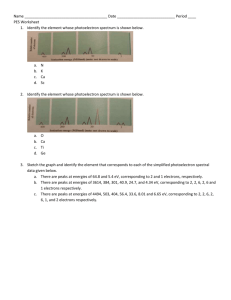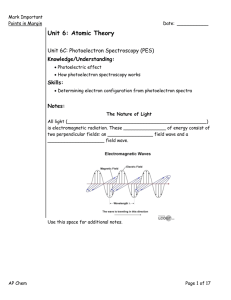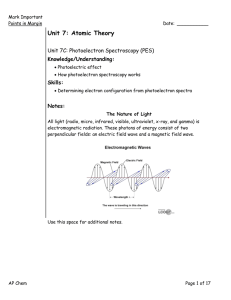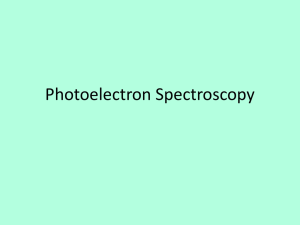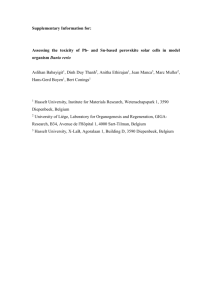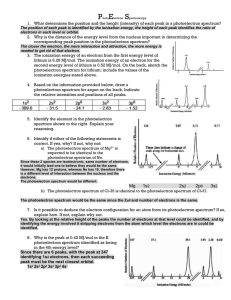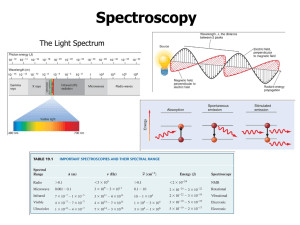Photoelectron Spectroscopy (PES)
advertisement
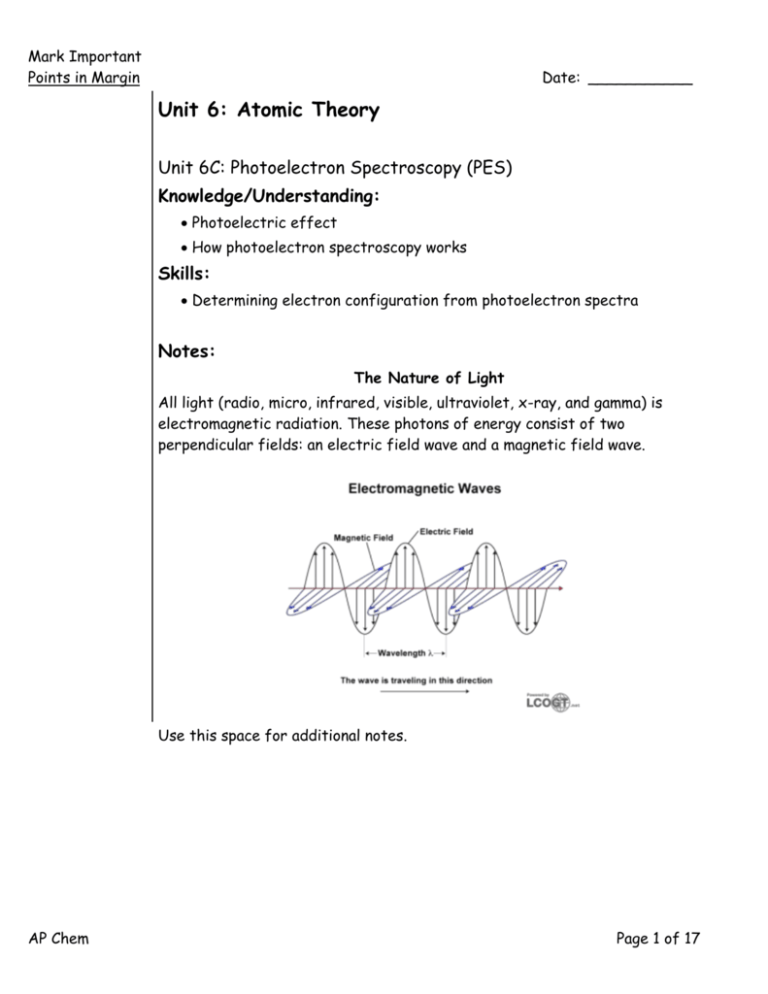
Mark Important Points in Margin Date: ___________ Unit 6: Atomic Theory Unit 6C: Photoelectron Spectroscopy (PES) Knowledge/Understanding: Photoelectric effect How photoelectron spectroscopy works Skills: Determining electron configuration from photoelectron spectra Notes: The Nature of Light All light (radio, micro, infrared, visible, ultraviolet, x-ray, and gamma) is electromagnetic radiation. These photons of energy consist of two perpendicular fields: an electric field wave and a magnetic field wave. Use this space for additional notes. AP Chem Page 1 of 17 Mark Important Points in Margin Photoelectron Spectroscopy (PES) These electromagnetic waves collectively make up the electromagnetic spectrum. Light Wave Properties Each electromagnetic wave has a unique set of wavelength, frequency, and energy values that describe it. Wavelength: The distance from crest (peak) to crest. Typically measured in nanometers (nm). (1m = 109nm) Use this space for additional notes. AP Chem Page 2 of 17 Mark Important Points in Margin Photoelectron Spectroscopy (PES) Frequency: The number of crests (peaks) that pass by a given point per second. Measured in units of 1/s or s-1. Speed of light: All light waves propagate at the same speed through a vacuum: 3.0x108 m/s Speed of Light Equation Wavelength and frequency are inversely related in proportion to the speed of light as described by the equation: c = λν *Note: make sure your units match! Units for c are m/s, so wavelength must be in meters before using the equation. Use this space for additional notes. AP Chem Page 3 of 17 Mark Important Photoelectron Spectroscopy (PES) Points in Margin Energy of a Photon Equation The energy of a light wave is directly proportional to its frequency and therefore indirectly related to its wavelength per the equations below: Planck’s Constant (h) = 6.63x10-34 Js The ability to quantify the energy of a light wave based upon its wavelength was used as evidence to support the presence of quantized energy levels via emission spectra. 3s 3s 1s 1s Same Wavelength Emitted/Absorbed = Same Energy Required to Move Between Energy Levels Use this space for additional notes. AP Chem Page 4 of 17 Mark Important Points in Margin Photoelectron Spectroscopy (PES) Duality of Light Light energy exhibits evidence of behaving both as a wave and as a particle. This duality is typically shown with the following experiments. Light as a wave Dual Slit Clip: https://www.youtube.com/watch?v=Iuv6hY6zsd0 Use this space for additional notes. AP Chem Page 5 of 17 Mark Important Points in Margin Photoelectron Spectroscopy (PES) Light as a particle Most commonly observed phenomena with light can be explained by waves. Phenomenon Can be explained in terms of waves. Can be explained in terms of particles. Reflection Refraction Interference Diffraction Polarization Photoelectric effect But the photoelectric effect suggested a particle nature for light. Use this space for additional notes. AP Chem Page 6 of 17 Mark Important Points in Margin Photoelectron Spectroscopy (PES) photoelectric effect: the observation that photons short-wave (visible or ultraviolet) light can cause it to emit electrons. This is an example of ionization, with the photons providing the ionization energy. When visible or ultraviolet light is shone on a substance, the energy from the photons of light excites electrons in the substance. If the energy exceeds the ionization energy of an atom in the substance, the electron is emitted. The emitted electrons are called photoelectrons. The effect is produced strongly by ultraviolet light and more weakly by lower frequencies. Light whose frequency was lower than a certain critical value did not eject any electrons at all. This dependence on frequency didn't make any sense in terms of the classical wave theory of light. Use this space for additional notes. AP Chem Page 7 of 17 Mark Important Points in Margin Photoelectron Spectroscopy (PES) If light is only behaving as a wave, it would consist of electric and magnetic fields. The stronger the fields, i.e., the greater the wave's amplitude, the greater the forces that would be exerted on electrons that found themselves bathed in the light. Therefore, it should have been amplitude (brightness) that was relevant, not frequency. However, the only effect amplitude (brightness) had on electron emission was the number of electrons emitted. It had no effect on their kinetic energy (speed they are eject with)! This provides evidence that light was behaving as “packets” of energy. The more we increase the intensity, the more packets of energy we are sending at the metal to come into contact with the electrons. Photoelectric Effect Simulation: http://phet.colorado.edu/en/simulation/photoelectric Use this space for additional notes. AP Chem Page 8 of 17 Mark Important Points in Margin Photoelectron Spectroscopy (PES) The dependence on frequency not only proves that the wave model of light needs modifying, but with the proper interpretation it allows us to determine how much energy is in one photon, and it also leads to a connection between the wave and particle models that we need in order to reconcile them. 1 eV = 6.24x1018 J A low-frequency red or infrared photon has less energy than the binding energy of the electron to its nucleus (EB), so a beam of them will not eject any electrons. A high-frequency blue or violet photon, on the other hand, packs enough of a punch to allow an electron to get out of the metal electrode. At frequencies higher than the minimum, the photoelectric current continues to increase with the frequency of the light as electrons are ejected with more and more kinetic energy (velocity). Use this space for additional notes. AP Chem Page 9 of 17 Mark Important Points in Margin Photoelectron Spectroscopy (PES) Photoelectron Spectroscopy photoelectron spectroscopy or photoemission spectroscopy (PES): using the energy from electrons emitted via the photoelectric effect to gain information about the electronic structure of a substance. The term “photoelectron spectroscopy” is generally used for the technique when applied to gases, and “photoemission spectroscopy” is generally used for electrons emitted from solid surfaces. In photoelectron (or photoemission) spectroscopy, a substance is bombarded with photons, which have a given amount of energy based on their frequency: E photon h By measuring the kinetic energy of the emitted electron, Ek, and predetermining the “work function”, Wo, of the substance (the amount of additional energy it takes to move the delocalized electron to the surface of the material—zero for gases, but nonzero for solids), we can calculate the binding energy, EB, of the electron from Einstein’s equation for the photoelectric effect: E k h E B Wo The photons used for photoelectron spectroscopy range from ultraviolet light to X-rays. Ultraviolet photoelectron spectroscopy (UPS) and extreme ultraviolet photoelectron spectroscopy (EUPS) are used to study valence electrons and the electrons that participate in chemical bonding. X-ray photoelectron spectroscopy (XPS) is most often used to study core electrons, particularly in solids. Use this space for additional notes. AP Chem Page 10 of 17 Mark Important Points in Margin Photoelectron Spectroscopy (PES) Interpreting Photoelectron Spectra The XPS spectrum for gold looks like the following: Notice that the peaks for 4s, 4p, 4d, and 4f are different heights. The height of the peak is proportional to the number of electrons in a given sublevel. Use this space for additional notes. AP Chem Page 11 of 17 Mark Important Points in Margin Photoelectron Spectroscopy (PES) Analysis of UV photoelectron spectra for a single element with a relatively low atomic number is straightforward. For example, the following is an idealized plot of the photoelectron spectrum for lithium: 2s 1s The x -axis has units of binding energy of the electron, usually electron-volts (eV). Recall that electrons in higher sublevels have less binding energy, which makes them easier to remove. This means the peak at the left corresponds with the easiest-to-remove electrons (for lithium, this is the 2s electron). The peak at the right corresponds with the electrons that are hardest to remove (for lithium, these are the two 1s electrons). The y -axis indicates the number of photons emitted with that energy. This means the height of each peak is proportional to the number of electrons in the corresponding sub-level. Notice that the peak at 6.26 eV (the 1s electrons) is twice as high as the peak at 0.52 eV (the 2s electron). This means there are twice as many electrons in the 1s sublevel as in the 2s sublevel. The only element that matches this spectrum is lithium (1s2 2s1). Use this space for additional notes. AP Chem Page 12 of 17 Mark Important Points in Margin Photoelectron Spectroscopy (PES) Sample Problem: Q: Identify the element represented by the following photoelectron spectrum: A: The spectrum shows three sublevels. If these peaks represent all of the electrons in the element, the peak at 19.3 eV must be from the 1s electrons, the peak at 1.36 eV must be from the 2s electrons, and the peak at 0.80 eV must be from a 2p electron. Therefore, the electron configuration must be 1s2 2s2 2p1, which means the element must be boron. Use this space for additional notes. AP Chem Page 13 of 17 Mark Important Points in Margin Photoelectron Spectroscopy (PES) Duality of Electrons It wasn’t long after the duality of light was discovered that similar behavior was theorized and supported for electrons. The particle behavior of electrons was well accepted and supported by multiple experiments, including the cathode ray. Use this space for additional notes. AP Chem Page 14 of 17 Mark Important Points in Margin Photoelectron Spectroscopy (PES) Additionally, the ability to reflect the cathode beam with a given electrostatic charge allowed for a specific mass to charge ratio to be determined. Evidence for mass characteristics supports particulate behavior. Use this space for additional notes. AP Chem Page 15 of 17 Mark Important Points in Margin Photoelectron Spectroscopy (PES) Young's duel slit experiment with electrons A group from the lab of Akira Tonomura performed an analogous experiment with electrons: Young's experiment, one electron at a time, from which we take the following images. Successively longer integration times as electron arrivals (white dots) are recorded. The constructive/destructive pattern mirrors the results of light waves from the duel-split experiment. Use this space for additional notes. AP Chem Page 16 of 17 Mark Important Points in Margin Photoelectron Spectroscopy (PES) Evidence for electron wave behavior provides further support for the Quantum Mechanical Model and the application of Schrödinger’s equation to predict electron positioning in orbitals, since it assumes wave behavior. Use this space for additional notes. AP Chem Page 17 of 17
